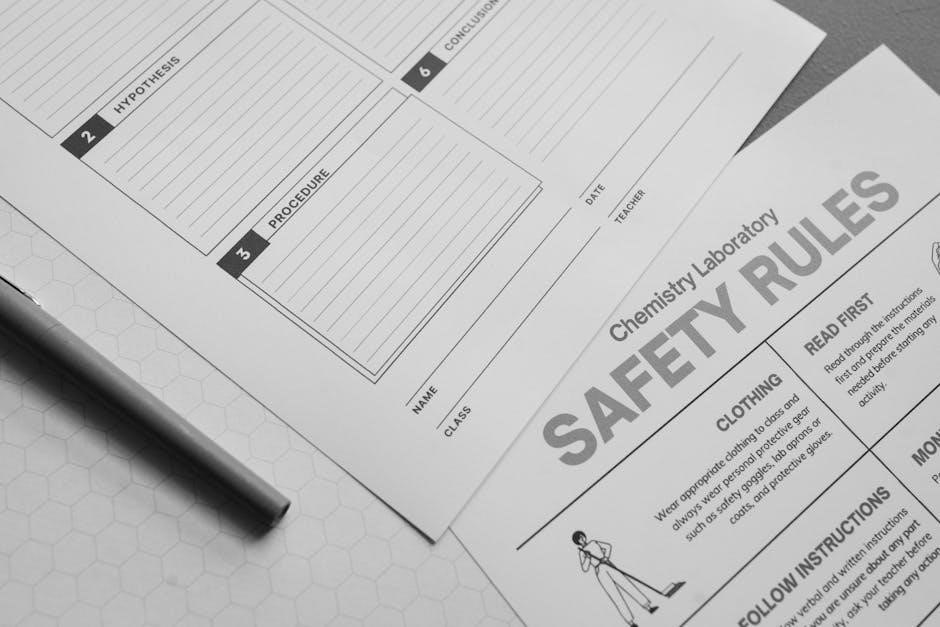Understanding the initial framework of the United States involves exploring Articles of Confederation worksheets, aiding students in analyzing this foundational, yet ultimately flawed, document.
These worksheets often present excerpts from the Articles, prompting critical thinking about its structure and purpose as a “league of friendship.”
The Articles, adopted in 1777, represented a deliberate attempt to avoid replicating the strong central authority experienced under British rule.
Historical Context: From Revolution to Confederation
Following the hard-fought victory in the Revolutionary War, the thirteen states found themselves independent but lacking a unified governing structure. The immediate need was coordination during wartime, but transitioning to peacetime demanded a more formal agreement.
The Articles of Confederation emerged from this necessity, representing a cautious response to the centralized power of the British monarchy. Colonists, wary of replicating perceived tyranny, prioritized state sovereignty.
Worksheets focusing on this period highlight the initial reluctance to establish a strong national government, emphasizing the desire to maintain autonomy. The Articles, adopted in 1777 and ratified in 1781, reflected this sentiment, creating a “firm league of friendship” rather than a robust union.
This historical context is crucial for understanding the Articles’ inherent weaknesses and eventual failure;
The Need for a First Government
Despite achieving independence, the newly formed United States faced significant challenges requiring collective action. Issues like interstate disputes, financial instability, and foreign relations demanded a coordinated response beyond the capabilities of individual states.
The absence of a central authority hindered trade, created economic chaos, and left the nation vulnerable. A unified government was essential to establish credit, negotiate treaties, and resolve conflicts peacefully.
Articles of Confederation worksheets often illustrate this need by presenting scenarios where the lack of central power led to practical problems. The Articles aimed to address these concerns, though ultimately proved inadequate.
Establishing a national government, even a limited one, was deemed vital for the survival and prosperity of the fledgling nation.

Key Features of the Articles of Confederation
Worksheets highlight a decentralized structure, granting states significant sovereignty and limiting the central government’s authority, reflecting a fear of replicating British power.
Structure of the Government Under the Articles
Analyzing Articles of Confederation worksheets reveals a unicameral Congress as the sole branch of the national government, with each state possessing equal representation, regardless of population size.
Worksheets demonstrate that there was no executive or judicial branch; committees of Congress handled executive functions, and state courts interpreted laws.
This structure, born from a desire to avoid centralized power, intentionally created a weak national government, prioritizing state autonomy.
Students using these worksheets can dissect how this design, a “firm league of friendship,” differed drastically from the later constitutional model.
The emphasis on state control is a recurring theme in document analysis, showcasing the initial reluctance to establish a strong federal authority.
Powers Granted to the Central Government
Articles of Confederation worksheets highlight the severely limited powers vested in the central government, reflecting the states’ fear of replicating British authority.
Congress could declare war, conduct foreign affairs, and make treaties, but lacked the power to tax directly, relying instead on requisitions from the states.
Worksheets emphasize that Congress couldn’t regulate interstate commerce, leading to economic disputes between states, a key weakness exposed in analyses.
The inability to enforce laws or compel state compliance further hampered the central government’s effectiveness, as illustrated in document-based questions.
Students learn through these worksheets that the Articles created a government with significant limitations, prioritizing state sovereignty above national unity.
State Sovereignty and Limited Central Authority
Articles of Confederation worksheets consistently demonstrate the paramount importance placed on state sovereignty, a direct reaction to perceived British overreach.
The Articles established a “firm league of friendship” among states, rather than a unified nation, with each state retaining considerable autonomy.
Worksheet activities often require students to identify clauses reinforcing state control, like the requirement of unanimous consent for amendments.
This emphasis on state power resulted in a weak central government, lacking the authority to effectively address national challenges, as worksheets reveal.
Analyzing primary source excerpts via worksheets underscores the deliberate choice to prioritize decentralized governance, ultimately contributing to the Articles’ failure.

Weaknesses of the Articles of Confederation
Articles of Confederation worksheets highlight critical flaws: financial instability, lack of trade regulation, and an inability to enforce laws, leading to significant national challenges.
Financial Problems and Economic Instability
Analyzing Articles of Confederation worksheets reveals a core weakness: the central government’s inability to effectively manage finances. Congress lacked the power to tax directly, relying instead on voluntary contributions from states – a consistently unreliable funding source.
This led to a substantial national debt accrued during the Revolutionary War, which the government struggled to repay. Worksheets often present scenarios illustrating states’ reluctance to contribute, hindering national creditworthiness.
Furthermore, the absence of a uniform currency created economic chaos, impeding interstate trade and fostering financial instability. Different states issued their own currencies, leading to fluctuating exchange rates and confusion. These worksheets demonstrate how these issues crippled the early American economy.
Lack of National Currency and Trade Regulations
Articles of Confederation worksheets frequently highlight the economic disarray stemming from the absence of a standardized national currency. Each state possessed the authority to coin money, resulting in a proliferation of varying currencies and significant confusion in commercial transactions.
This fragmented monetary system severely hampered interstate trade, as merchants faced difficulties in establishing consistent exchange rates and settling debts. Worksheets often present calculations demonstrating the complexities of trade with multiple currencies.
Moreover, Congress lacked the power to regulate commerce, meaning states could impose tariffs on each other’s goods, creating trade barriers and economic friction. These limitations, explored through worksheet exercises, underscored the urgent need for economic unification.
Inability to Enforce Laws and Resolve Disputes
Articles of Confederation worksheets consistently emphasize the central government’s crippling weakness in enforcing laws and resolving disputes between states. Congress, lacking an executive branch or a national judiciary, could only request compliance from the states, possessing no coercive power.
This deficiency led to frequent disregard for congressional requests and an inability to settle boundary disputes or enforce contracts across state lines. Worksheet scenarios often depict conflicts arising from this lack of enforcement.
The absence of a national court system meant there was no impartial arbiter to resolve disagreements, fostering resentment and instability. Analyzing these limitations via worksheets reveals why a stronger federal government became essential.

Shays’ Rebellion and its Impact
Articles of Confederation worksheets often highlight Shays’ Rebellion as a pivotal event, exposing the central government’s inability to maintain order and quell unrest effectively.
The Causes of Shays’ Rebellion
Analyzing Articles of Confederation worksheets reveals that Shays’ Rebellion stemmed from severe economic hardships faced by Massachusetts farmers post-Revolutionary War.
High taxes, coupled with a lack of a national currency and stringent debt collection policies, created immense financial pressure on these individuals.
Many farmers, unable to pay their debts, faced foreclosure and imprisonment, fueling resentment towards the state government.
Worksheets emphasize that the central government, operating under the Articles, lacked the power to effectively address these economic grievances or provide relief.
This powerlessness, combined with a perceived lack of responsiveness from the state legislature, ultimately ignited the rebellion led by Daniel Shays.
The rebellion wasn’t simply about debt; it was a protest against perceived injustice and governmental overreach.
The Rebellion’s Exposure of the Articles’ Weaknesses
Articles of Confederation worksheets demonstrate how Shays’ Rebellion dramatically exposed the fundamental flaws within the nation’s first governing document.
The inability of the central government to raise a national army to quell the uprising highlighted its lack of authority and enforcement power.
States were reluctant to provide aid, revealing the limited sense of national unity and the strong emphasis on state sovereignty.
Worksheets often ask students to consider how this event underscored the need for a stronger federal government capable of maintaining domestic tranquility.
The rebellion served as a wake-up call, illustrating the dangers of a decentralized system lacking the capacity to address internal threats effectively.
It fueled the growing momentum for a constitutional convention to revise – and ultimately replace – the Articles.
The Constitutional Convention of 1787
Articles of Confederation worksheets prepare students to understand how dissatisfaction with the Articles led to a 1787 convention intending to revise, but ultimately replacing it.
From Revision to Replacement
Initially, delegates convened in Philadelphia with the modest goal of amending the Articles of Confederation. However, analyzing Articles of Confederation worksheets reveals the depth of the problems inherent in the existing governmental structure, quickly shifting the focus.
Discussions surrounding states’ rights, economic instability, and the inability to enforce laws demonstrated that piecemeal fixes were insufficient. The delegates, armed with a clear understanding of the Articles’ shortcomings – often reinforced through document analysis worksheets – realized a more fundamental overhaul was necessary.
Consequently, the convention abandoned efforts at revision and embarked on the ambitious task of drafting an entirely new framework for governance, culminating in the United States Constitution. This transition highlights the pivotal role of recognizing systemic flaws.
Drafting a New Framework of Government
The Constitutional Convention tackled the deficiencies exposed by studying the Articles of Confederation, often through detailed worksheets examining its weaknesses. Delegates debated key issues like representation, slavery, and the balance of power between states and the federal government.
Compromises, such as the Great Compromise and the Three-Fifths Compromise, were essential to forging consensus. These negotiations aimed to create a system that addressed the concerns of both large and small states, and navigated the contentious issue of slavery.
Ultimately, the resulting Constitution established a federal republic with a stronger central government, incorporating lessons learned from the failures of the Articles, as evidenced by comparative analyses in educational materials.

Analyzing Articles of Confederation Worksheets
Worksheets focus on document analysis, identifying strengths and weaknesses, and understanding the shift from a loose confederation to a more unified national government.
Students dissect primary source excerpts, fostering comprehension of the Articles’ limitations.
Purpose and Content of Typical Worksheets
Typical Articles of Confederation worksheets aim to solidify student understanding of the nation’s first governing document, emphasizing its historical context and inherent limitations. These resources frequently include excerpts from the Articles themselves, prompting students to engage directly with the primary source material.
Content often centers around identifying the structure of government established – or rather, not fully established – under the Articles, and analyzing the powers granted (or not granted) to the central authority.

Many worksheets incorporate activities like matching key terms, completing charts comparing state and federal powers, and answering comprehension questions. Some utilize “strength and weakness” card sorting exercises, encouraging critical evaluation. The goal is to prepare students to understand why the Articles ultimately failed and necessitated the Constitutional Convention of 1787.
Using Worksheets for Student Understanding
Articles of Confederation worksheets are invaluable tools for fostering student comprehension of this pivotal period in American history. Employing these resources allows educators to move beyond rote memorization, encouraging analytical skills.
Worksheets facilitate active learning by requiring students to dissect the document, identify its core principles, and evaluate its shortcomings. Analyzing excerpts promotes close reading and source analysis skills.
Pair or group work with worksheets encourages collaborative discussion and peer teaching. Teachers can use completed worksheets as formative assessments, gauging student understanding and tailoring instruction accordingly. The card-sorting activities, for example, promote debate and justification of opinions. Ultimately, these tools bridge the gap between historical text and student comprehension.

Resources for Studying the Articles
Online access to primary source documents and accompanying worksheets, like those analyzing the Articles, provides students with direct engagement with historical materials.
Educational websites offer curated resources, simplifying complex concepts and enhancing learning experiences.
Primary Source Documents Online
Accessing the original Articles of Confederation online is crucial for in-depth study; several reputable archives host digitized versions, allowing students to examine the text directly.
Many educational platforms supplement these documents with downloadable worksheets designed to guide analysis, focusing on key clauses and their implications.
These worksheets often include questions prompting students to identify the powers granted to Congress, the limitations imposed on central authority, and the sovereignty retained by individual states.

Resources like the Library of Congress and the National Archives provide not only the Articles themselves but also contextual materials, such as letters and debates from the period, enriching understanding.
Utilizing these primary sources alongside structured worksheets fosters critical thinking and a nuanced appreciation of this formative period in American history.
Educational Websites and Materials
Numerous websites offer comprehensive resources for studying the Articles of Confederation, frequently including downloadable worksheets tailored for various grade levels.
These materials often present the Articles in a student-friendly format, breaking down complex clauses and providing definitions of key terms, alongside analytical worksheets.
Sites like iCivics and Khan Academy provide interactive lessons and assessments, complementing traditional worksheets and fostering a deeper understanding of the document’s strengths and weaknesses.
Teachers Pay Teachers also hosts a variety of Articles of Confederation worksheets created by educators, offering diverse approaches to learning and assessment.
These online resources, combined with thoughtfully designed worksheets, empower students to critically evaluate this pivotal moment in American history.

The Legacy of the Articles of Confederation
Analyzing Articles of Confederation worksheets reveals its impact on the Constitution, highlighting lessons learned about balancing state sovereignty with a strong national government.
Worksheets demonstrate the need for a more effective framework.
Influence on the U.S. Constitution
Examining Articles of Confederation worksheets illuminates how the failures of the first government directly shaped the U.S. Constitution. The worksheets often highlight the weaknesses – a lack of central authority, inability to tax effectively, and difficulties regulating trade – which spurred the call for a Constitutional Convention in 1787.
Specifically, the Constitution addressed these shortcomings by establishing a federal system with divided powers, granting Congress the power to levy taxes, and regulating interstate commerce. The emphasis on a stronger national government, while respecting state rights, was a direct response to the inadequacies exposed through studying the Articles via these educational tools.
Furthermore, the worksheets demonstrate how the framers intentionally created a system designed to prevent the same issues that plagued the Confederation period, ensuring a more stable and unified nation.
Lessons Learned from the First Attempt at Governance
Analyzing Articles of Confederation worksheets reveals crucial lessons about the necessity of a balanced government. The worksheets underscore the dangers of excessive state sovereignty and a deliberately weak central authority, leading to financial instability and internal disputes.
Students, through these exercises, grasp the importance of a national currency, uniform trade regulations, and a system capable of enforcing laws. The Articles’ failure to address these issues, vividly illustrated in worksheet analyses, demonstrated the need for a more robust federal structure.
Ultimately, the Confederation experience, brought to life through these learning materials, taught the founders that a functional government requires both power and limitations, a principle enshrined in the Constitution.

















































































